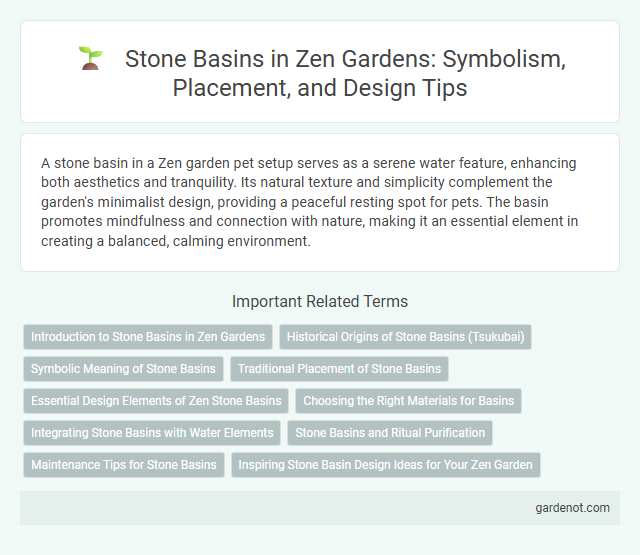A stone basin in a Zen garden pet setup serves as a serene water feature, enhancing both aesthetics and tranquility. Its natural texture and simplicity complement the garden's minimalist design, providing a peaceful resting spot for pets. The basin promotes mindfulness and connection with nature, making it an essential element in creating a balanced, calming environment.
Introduction to Stone Basins in Zen Gardens
Stone basins, known as tsukubai, are integral elements in Zen gardens, symbolizing purity and serenity. Traditionally crafted from granite or other natural stones, these basins hold water for ritual cleansing, embodying mindfulness and simplicity in design. Their placement near pathways or tea houses encourages contemplation and a connection with nature's tranquility.
Historical Origins of Stone Basins (Tsukubai)
Stone basins, known as Tsukubai, originated during Japan's Edo period as ritual cleansing vessels in tea ceremonies, symbolizing humility and purity. These basins were traditionally crafted from natural river stones, set at a low height to encourage bowing, reflecting Zen Buddhist principles. The design and use of Tsukubai continue to embody spiritual cleansing and mindfulness in Japanese Zen gardens today.
Symbolic Meaning of Stone Basins
Stone basins in Zen gardens symbolize purity and spiritual cleansing, reflecting the practice of washing away distractions before meditation. These basins often represent a serene invitation to mindfulness, embodying the principle of simplicity and tranquility central to Zen philosophy. Their placement and design emphasize harmony with nature, reinforcing the garden's role as a contemplative sanctuary.
Traditional Placement of Stone Basins
Stone basins in traditional Zen gardens are strategically placed near the entrance or beside pathways to encourage mindfulness and ritual purification. Often positioned at the edge of a water source or nestled among natural rocks and plants, these basins create a harmonious balance between functionality and aesthetics. The careful placement emphasizes simplicity and the connection between water, stone, and nature, reinforcing the garden's meditative atmosphere.
Essential Design Elements of Zen Stone Basins
Zen stone basins, known as tsukubai, are essential design elements characterized by their natural materials, simple shapes, and subtle textures that harmonize with the surrounding environment. The basin is typically carved from granite or river stone, allowing water to collect quietly, symbolizing purity and mindfulness in Zen gardens. Placement near pathways or beside bamboo water spouts complements the garden's aesthetic while promoting tranquility and meditative reflection.
Choosing the Right Materials for Basins
Selecting stone basins for a Zen garden requires careful consideration of natural materials such as granite, basalt, and river stone due to their durability and aesthetic harmony with the environment. Granite offers strong resistance to weathering and a textured surface that enhances the garden's tactile appeal, while basalt provides deep, rich coloration that complements moss and greenery. River stones bring organic shapes and smooth finishes, promoting a soothing visual flow essential for the meditative atmosphere of a Zen garden.
Integrating Stone Basins with Water Elements
Integrating stone basins with water elements enhances the tranquility and aesthetic harmony of a Zen garden by creating a focal point that symbolizes purity and calmness. The natural texture and form of stone basins complement flowing water, promoting mindfulness through gentle sounds and reflective surfaces. This synergy fosters a serene atmosphere, inviting meditation and deep connection with nature.
Stone Basins and Ritual Purification
Stone basins, known as tsukubai, play a crucial role in Zen gardens by serving as ritual purification stations for visitors before entering sacred spaces. Crafted from natural stone, these basins collect water used in hand-washing ceremonies symbolizing spiritual cleansing and mindfulness. The integration of stone basins enhances the garden's meditative atmosphere, emphasizing simplicity and the Zen aesthetic of harmony with nature.
Maintenance Tips for Stone Basins
Regular cleaning of stone basins using a soft brush and mild soap prevents moss and algae buildup, preserving the stone's natural texture. Avoid harsh chemical cleaners that can erode the surface, and rinse thoroughly with clean water after each wash. Applying a stone sealant every six months enhances durability by protecting against water stains and weathering in Zen garden environments.
Inspiring Stone Basin Design Ideas for Your Zen Garden
Stone basins in Zen gardens offer a serene focal point that evokes tranquility and mindfulness, often crafted from natural granite or basalt to blend seamlessly with the environment. Designs featuring minimalist shapes, such as smooth, rounded bowls or rectangular troughs, emphasize simplicity and balance, enhancing the meditative atmosphere. Incorporating moss or bamboo elements around the stone basin intensifies its organic aesthetic while promoting a harmonious connection with nature.
Stone basin Infographic

 gardenot.com
gardenot.com